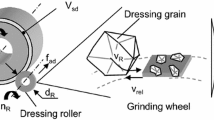Abstract
A targeted adjustment of the dressing results and the methodological influence of the dressing process on the non-stationary wear of a grinding wheel after dressing increases the productivity and the reproducibility of grinding processes. Despite the great economic importance of grinding processes with vitrified corundum grinding wheels and the great relevance of the dressing process for the application behavior of these grinding wheels, quantitative models are missing for the purposeful design of the dressing process. In previous studies, a dressing model was successfully developed which predicts the dressing force in the dressing process as well as the workpiece roughness and the grinding wheel wear behavior in a grinding process for a specific grinding wheel and form roller specification. However, a transferability of this model to other grinding wheel and form roller specifications is not possible because the influence of the grain size and the hardness of the grinding wheel as well as the dressing tool topography on the grinding wheel wear and thus on parameters of the dressing model are not known. The objective of this work was to extend the model to additional grinding wheel and form roller specifications to ensure a broad applicability of the model.







Similar content being viewed by others
Abbreviations
- ∆r s :
-
Grinding wheel radial wear (µm)
- a e :
-
Depth of cut (µm)
- a ed :
-
Depth of dressing cut (µm)
- A hd :
-
Mean dressing chip cross section (µm2)
- a pd :
-
Dressing contact width (mm)
- f ad :
-
Axial dressing feed per grinding wheel revolution (mm)
- F nd :
-
Dressing normal force (N)
- l kd :
-
Kinematic contact length (mm)
- q d :
-
Dressing speed ratio (−)
- R² :
-
Coefficient of determination (−)
- U d :
-
Dressing overlap ratio (−)
- v rd :
-
Velocity of the form roller (m/s)
- v s :
-
Grinding wheel circumferential speed (m/s)
- v sd :
-
Grinding wheel circumferential speed during dressing (m/s)
- V sd,pg :
-
Dressed grinding wheel volume per grain (mm3)
- v w :
-
Workpiece speed (m/min)
- V′ w :
-
Specific material removal (mm3/mm)
References
Marinescu ID, Row WB, Dimitrov B, Inasaki I (2004) Tribology of abrasive machining processes. William Andrew Inc. ISBN: 0-8155-1490-5
Uhlmann E, Hochschild L (2013) Tool optimization for high speed grinding. Prod Eng Res Dev 7:185–193
Denkena B, Köhler J, Woiwode S (2014) Dressing of vitrified bonded CBN tools for continuous generating grinding. Prod Eng Res Dev 8:585–591
Tönshoff HK, Friemuth T, Hessel D (2001) Crushing process for vitreous bonded CBN and diamond grinding wheels. Prod Eng Res Dev 8(1):13–16
Chen X, Rowe WB (1996) Analysis and simulation of the grinding process. Int J Mach Tools Manuf 36:871–882
Malkin S (1989) Grinding technology: theory and applications of machining with abrasives. Elli Horwood Limited, Hemel Hempstead
Shaw MC (1996) Principles of abrasive processing. Clarendon Press, Oxford, pp 144–163
Linke B (2008) Dressing process model for vitrified bonded grinding wheels. Ann CIRP Manuf Technol 57:345–348
Brinksmeier C, Çinar M (1995) Characterisation of dressing processes by determination of the collision number of the abrasive grits. Ann CIRP 44:299–303
Klocke F, Thiermann J, Weiß M (2013) Abrichtprozess bestimmt den Schleifscheibenverschleiß - Einfluss der Belastung im Abrichtprozess auf das Verschleißverhalten der Schleifscheibe. wt Werkstattstechnik online 103(6):488–492
Wegener K, Hoffmeister H-W, Karpuschewski B, Kuster F, Hahmann W-C, Rabiey M (2011) Conditioning and monitoring of grinding wheels. Ann CIRP 60:757–777
Klocke F, Thiermann J, Mattfeld P (2015) Influence of the dressing process on grinding wheel wear. Prod Eng Res Dev 9:563–568
Acknowledgements
The authors would like to thank the German Research Foundation (DFG) for funding the research project “Quantitatives Modell des Abrichtens von keramisch gebundenen Schleifscheiben” (KL 500/99-2).
Author information
Authors and Affiliations
Corresponding author
Rights and permissions
About this article
Cite this article
Prinz, S., Trauth, D., Mattfeld, P. et al. Influence of different grinding wheel and dressing roller specifications on grinding wheel wear. Prod. Eng. Res. Devel. 12, 441–448 (2018). https://doi.org/10.1007/s11740-018-0810-7
Received:
Accepted:
Published:
Issue Date:
DOI: https://doi.org/10.1007/s11740-018-0810-7




